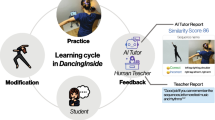Abstract
This paper presents the design, development and evaluation of a prototype intelligent dance tutoring system, DanceTutor, for coaching students in low-resource settings. The system evaluates seventeen core body points on a dancer using video footage captured from a mobile phone or web camera using a combination of simple algorithms and 2D pose estimation software. Detailed feedback is provided on the quality and correctness of the dancer’s pose for the first five static dance positions in Ballet, and then for intermediate to advanced exercises with permutations of the five basic Ballet positions. Evaluation of the prototype revealed the highly subjective nature and cultural biases of evaluating the quality of a dancer’s technique. Three experienced dance teachers, trained in different countries, evaluated 165 video recordings of 11 candidate dancers. The system was only able to achieve 47% consensus overall with the feedback and grading results produced by the dance teachers, who each evaluated tension and height differently. There was however a 60% agreement between DanceTutor and one teacher who used the most granular evaluation strategy matching DanceTutor’s baseline and assessment features.
Access this chapter
Tax calculation will be finalised at checkout
Purchases are for personal use only
Similar content being viewed by others
References
Daniaa, A., Hatziharistosa, D., Koutsoubaa, D., Tyrovolaa, V.: The Use of Technology in Movement and Dance Education: Recent Practices and Future Perspectives, pp. 3–4. Athens, Greece: Elsevier Ltd (2011). https://doi.org/10.1016/j.sbspro.2011.04.299
Trajkova, M., Francesco, C.: Takes tutu to ballet: designing visual and verbal feedback for augmented mirrors. Proc. ACM Interact. Mobile, Wearable Ubiquit. Technol. 2(1), 1–30 (2018). https://doi.org/10.1145/3191770
Cheng, D., Hartmann, B., Chi, P., Wright, P., Kwak, T.: Body-Tracking Camera Control for Demonstration Videos, Paris, France: CHI 2013 Extended Abstracts on Human Factors in Computing Systems, pp. 1–6 (2013). https://doi.org/10.1145/2468356.2468568
Huang, H., Uejo, M., Seki, Y., Lee J., Kawagoe, K.: Realizing real-time feedback on learners’ practice for a virtual ballroom dance instructor, pp. 5–6. Workshop on Real-time Conversations with Virtual Agents (RCVA), IVA 2012, Santa Cruz, USA (2012)
Marquardt, Z., Beira, J., Paiva, I., Em, N., Kox, S.: Super Mirror: a kinect interface for ballet dancers, pp. 1–6. CHI EA 2012 (2012). https://doi.org/10.1145/2212776.2223682
Anderson, F., Grossman, T., Matejka, J., Fitzmaurice, G.: YouMove: enhancing movement training with an augmented reality mirror, pp. 311–319. In: Proceedings of the 26th ACM Symposium on User Interface Software and Technology (2013). https://doi.org/10.1145/2501988.2502045
Shotton, J., Fitzgibbon, A.: Real-time human pose recognition in parts from single depth images, pp. 1–8. In Proceedings of the 24th IEEE Conference on Computer Vision and Pattern Recognition, CVPR 2011, Colorado Springs, USA, pp. 20–25 (2011). https://doi.org/10.1109/CVPR.2011.5995316
Zhe Cao, G., Hidalgo, S., Wei, S., Sheikh, Y.: OpenPose: realtime multi-person 2D Pose Estimation using part affinity fields, pp. 1–14. IEEE Transactions on Pattern Analysis and Machine Intelligence (2019). https://doi.org/10.1109/TPAMI.2019.2929257
Author information
Authors and Affiliations
Editor information
Editors and Affiliations
Rights and permissions
Copyright information
© 2021 Springer Nature Switzerland AG
About this paper
Cite this paper
Maharaj-Pariagsingh, L., Mohammed, P.S. (2021). DanceTutor: An ITS for Coaching Novice Ballet Dancers Using Pose Recognition of Whole-Body Movements. In: Roll, I., McNamara, D., Sosnovsky, S., Luckin, R., Dimitrova, V. (eds) Artificial Intelligence in Education. AIED 2021. Lecture Notes in Computer Science(), vol 12749. Springer, Cham. https://doi.org/10.1007/978-3-030-78270-2_47
Download citation
DOI: https://doi.org/10.1007/978-3-030-78270-2_47
Published:
Publisher Name: Springer, Cham
Print ISBN: 978-3-030-78269-6
Online ISBN: 978-3-030-78270-2
eBook Packages: Computer ScienceComputer Science (R0)




